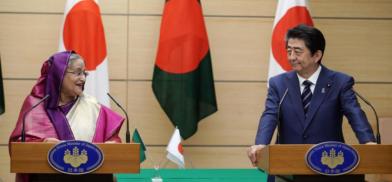Will Bangladesh be able to lure more Japanese investment?
Attracting Japanese companies shifting out of China thus is consistent with Bangladesh’s Look East policy. To facilitate this a Special Economic Zone is being built, writes N Chandra Mohan for South Asia Monitor

Like India, South Asian neighbours like Bangladesh, too, seek to attract Japanese companies intending to relocate out of China. The Japanese government has provided USD 2.2 billion to subsidise this process - of which USD 2 billion is to relocate back home - as its firms face higher wage costs and seek to de-risk and diversify their investments to alternative geographies.
Some of those who opted headed to Vietnam, Thailand, and Indonesia. Bangladesh (and India) have been added to the list as preferred destinations. Bangladesh is accordingly rolling out a red carpet to welcome such Japanese companies to relocate to the country.
Bangladesh as an investment destination
Bangladesh is of course no stranger to Japanese involvement as 300 companies currently operate in that country. It has featured in JETRO (Japan External Trade Organisation’s) surveys as a top investment destination for its low wages and competitive production costs. Some companies have already tested the waters, which send positive signals to other prospective Japanese investors.
In November 2018, a big-ticket acquisition was made by Japan Tobacco International of the Akij Group’s tobacco business. At the same time, Bangladesh Honda Pvt Ltd, Honda’s joint venture in Bangladesh, started manufacturing motorcycles in Munshiganj.
The Japanese government, for its part, has provided Official Development Assistance loans for major infrastructural projects like developing a deep sea port in Matarbari area of Cox’s Bazar District, Dhaka Mass Rapid Transit Development, Terminal 3 of the Hazrat Shahjalal International Airport Expansion, among several others. Both Japan and Bangladesh see projects like the deep seaport as integral to a larger Bay of Bengal Industrial Growth Belt Initiative to leverage the latter’s geostrategic location between South Asia and South-East Asia. Bangladesh seeks to harness the bustling opportunities from the Indian Ocean to the Pacific.
Attracting Japanese companies shifting out of China thus is consistent with Bangladesh’s Look East policy. To facilitate this a Special Economic Zone is being built in the sub-district of Araihazar, which is 32 km away from Dhaka and is expected to become operational by 2022.
Japan has allocated USD 350 million in special loans to develop this USD 1 billion zones on 1,000 acres, the largest such assistance for an SEZ in Asia. The Bangladesh Economic Zones Authority expects this SEZ to attract USD 20 billion in Japanese investments. It is seeking the participation of Suzuki Motor Corporation and Mitsubishi, according to Bloomberg.
Not easy to shift from China
The big question is how many companies will make this shift? For all the talk of an impending relocation, indications are that foreign investors are in no tearing hurry to move out of China. Despite being adversely impacted by the COVID-19 pandemic and the threat of a US-China trade war, they prefer to conserve their investible resources instead of rushing off to alternative locations in Asia, including Bangladesh and India.
But if they indeed do so, they will seriously check out the business environment, state of infrastructure, availability of raw materials, and labour with the requisite skills, the host nation’s tax regime, and regulations, among others.
For all the bullish JETRO surveys, Japanese business, unlike say the South Korean, doesn’t take decisions to invest in a hurry. Take India’s experience, for instance. Many business delegations visited the country over the years. While they are unfailingly effusive about the country’s potential and reforms, their investments in the country - USD 34 billion or 7 percent of total inflows between April 2000 and September 2020 - are a bare fraction of their investments in ASEAN countries.
Big-ticket investments are bedeviled by concerns over the complicated legal and tax system, difficult labour issues, inadequate infrastructure, poor contract enforcement, etc.
Problems for investors
The harsh truth is that there are no greener pastures for Japanese investors in Bangladesh. The conditions for doing business on the ground matter in their decisions. For starters, the biggest problem faced by Japanese businesses in Bangladesh has been the difficulty in procuring raw materials and parts locally. Just 23 percent of raw materials are procured from the country by manufacturing companies.
In fact, 52 percent of production costs incurred by Japanese manufacturing firms are material costs, according to Farhan Uddin of LightCastle Partners, a consultancy firm. Then are endemic power shortages, delayed custom clearances, etc.
Nevertheless, there is a buzz regarding more Japanese firms setting up production facilities in Bangladesh. Currently, they are the 11th largest foreign investor with investments of USD 72 million in 2019, according to the Bangladesh Bank. More FDI (Foreign Direct Investment) is welcome to boost the overall economic growth in that country that hit an estimated low of 2 percent in the financial year ended June 2020 and worsen to 1.6 percent in 2020-21, according to the World Bank.
Foreign investments will catalyse greater trade and regional integration and breathe fresh life into the Bay of Bengal Initiative for Multi-Sectoral Technical and Economic Cooperation (BIMSTEC) whose permanent secretariat is in Dhaka.
(The writer is an economics and business commentator based in New Delhi. His views are personal. He can be contacted at nchandramohan@rediffmail.com)









Post a Comment